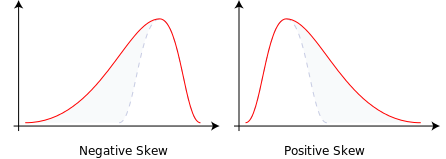A distribution in which values equidistant from the mean have equal frequencies is called symmetrical distribution. Any departure from symmetry is called skewness.
A perfect symmetrical distribution is a distribution where 1) mean, median and mode coincide and 2) the two tails of the distribution are equal in length from the mean. A distribution departs from symmetry when some values of the variable occur at irregular frequencies. Consequently mean, mode and median are not at one point and one tail becomes longer than the other.
What is positive and negative skewness?
If the right tail is longer than the left tail, the distribution is said to have positive skewness. If the left tail of a distribution is longer than its right tail, it is said to be negatively skewed or to have negative skewness. In a positively skewed distribution, the mean is greater than the median and the median is greater than the mode, i.e. mean > median > mode and in a negatively skewed distribution, mode>median>mean.
What is measure of skewness?
Skewness is a measure of the asymmetry of the probability distribution of real-valued random variable about its mean. The difference between the measures of location, being an indication of the amount of skewness or asymmetry, is used as a measure of skewness.
A measure of skewness is defined in such a way that
- the measure should be zero when the distribution is symmetric, and
- the measure should be a pure number, i.e. independent of origin and units of origin and units of measurement.
Skewness can be positive, negative or undefined.

